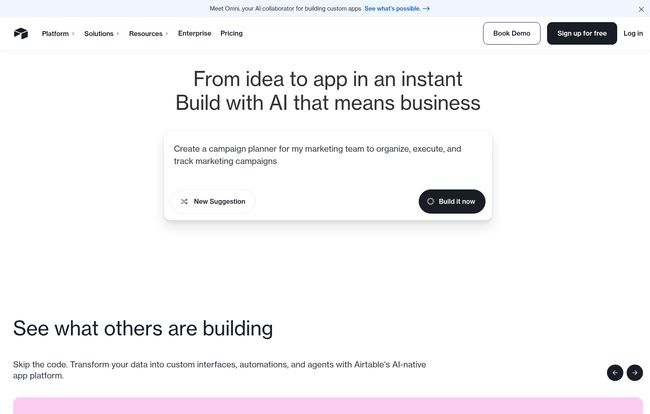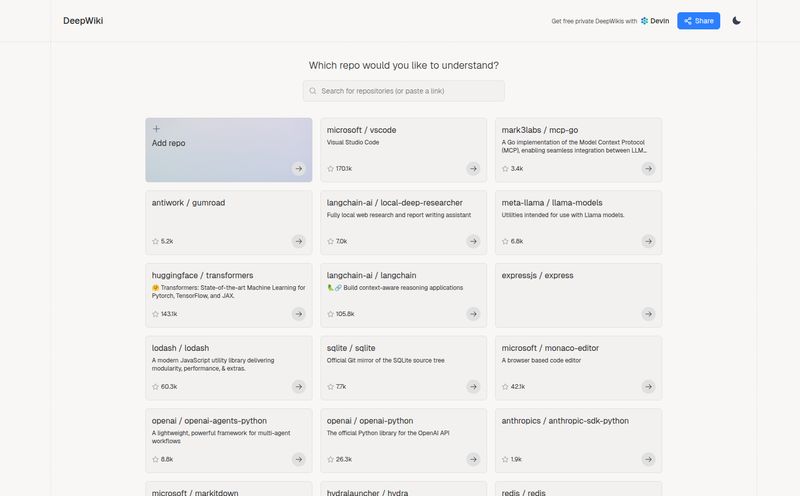Airtable Review: My Honest Take on the 'Spreadsheet on Steroids'
For years, we've been hearing about the “no-code revolution.” This grand promise that anyone, not just the code-wielding wizards in the IT department, could build the exact tools they need. I’ve seen a lot of platforms come and go, some brilliant, some... well, not so much. And right in the middle of it all, there’s Airtable.
For the longest time, everyone called it “spreadsheets on steroids.” A cute, catchy phrase, but honestly, it sells it short. It’s like calling a smartphone a “calculator that makes calls.” Sure, it does that, but you’re missing the whole point. And now, with their huge push into AI, Airtable is making a bold claim: they’re not just a database, they’re an app-building platform that can 10x your team.
Big words. But as someone who lives and breathes data, workflows, and traffic, I have to ask: Is it just marketing fluff, or is there some real fire behind all that smoke? Let's get into it.
So What Exactly is Airtable? (Please Don’t Call It a Spreadsheet)
Okay, at first glance, it looks like a spreadsheet. It has grids, columns, rows. It's familiar, which is smart. But that’s where the comparison ends. Think of Airtable as a box of incredibly powerful digital Legos. A spreadsheet is a flat piece of paper; Airtable is a 3D model you can build, connect, and automate.
At its core, it’s a relational database. Whoa, don't let that scary term throw you. All it means is that you can link different sets of information together. Imagine you have a list of blog posts. And another list of writers. And a third list of social media campaigns. In a spreadsheet, those are just three separate, dumb lists. In Airtable, you can link them. You can see which writer wrote which post, and which campaigns are promoting it, all in one clean view. That’s the magic.
You work with “Bases” (the whole project or database), which contain “Tables” (like spreadsheet tabs), which are made of “Fields” (the columns). But these aren't just text fields. They can be checkboxes, dropdowns, attachments, links to other tables—it's a whole different ballgame.
The New AI in the Room: Airtable's Big Bet
Lately, you can't throw a rock without hitting a company talking about AI. Airtable is no exception. Their homepage screams it: “From idea to app in an instant. Built with AI that means business.” They've rolled out Airtable AI, and it’s meant to be your built-in data assistant.
The promise is huge. It can help you analyze data in your base, do web research, draft emails, summarize meeting notes, and even help structure your data in the first place. I’ve seen it demoed, and it’s slick. It uses a mix of top-tier models like OpenAI’s GPT, Google’s Gemini, and others, so it’s got some serious horsepower under the hood.
“We finally have a system that keeps up with the business.” - Jan Sauer, Head of MarTech, Airtable Customer Quote
This is where things get really interesting. For an SEO like me, the potential to quickly analyze keyword data, categorize content ideas, or draft outreach emails without leaving the platform is... tempting. Very tempting. But as we all know, promise and daily reality can be two very different things. We'll touch on the cost of this magic later on.

Visit Airtable
The Good Stuff: Why Airtable Has a Permanent Tab Open on My Browser
Despite any gripes I might have, I use Airtable. A lot. Here’s why it keeps pulling me back in.
Building Without Code is Genuinely Liberating
This is the core appeal. I'm not a developer. I can hack my way through some basic HTML, but building an application from scratch? Not a chance. A few months ago, I needed a comprehensive system to track our content pipeline, from initial idea to published article, including guest post pitches and backlinks. In about two hours, I had a working Airtable base that did everything I needed. It had a Kanban view for progress, a calendar for deadlines, and a gallery view for featured images. A task that would’ve been a nightmare of spreadsheets or required expensive project management software was just… done. That feeling of empowerment is hard to beat.
It’s a Swiss Army Knife for Integrations
A tool that doesn’t play well with others is a useless tool. Airtable gets this. It connects to pretty much everything. Through its own automations or by hooking into services like Zapier or Make, you can make it the central nervous system of your operations. New lead in Salesforce? Create a record in Airtable. New file in Google Drive? Attach it to a project in Airtable. A mention on Slack? Log it in your media tracking base. It stops being just one tool and becomes the hub that connects all your other tools.
You Can Mold It To Your Will
The customization is just fantastic. You're not stuck with one look. You can view the same data as a grid, a beautiful gallery of images, a drag-and-drop Kanban board, a calendar, or even a timeline. On top of that, you can build custom “Interfaces,” which are basically simple, interactive webpages that let your team (or clients) see and edit only the data they need to. No more overwhelming them with a massive table of 50 columns. This is probably one of its most powerful, and under-appreciated, features.
The Hurdles: My Airtable Pet Peeves
Okay, it’s not all sunshine and automated roses. There are a few things that make me grumble.
That Learning Curve Can Be a Steep Climb
While it starts easy, to really use Airtable, you have to shift your brain from “spreadsheet mode” to “database mode.” If you've never heard of a `lookup field` or a `junction table`, your first few hours might feel a bit disorienting. It's more intuitive than, say, Microsoft Access (shudder), but it's not quite as simple as just typing in a cell. There’s a hump you have to get over.
The Pricing… Oh, the Pricing
This is my biggest issue. The pricing structure can feel a little… complex. It’s a per-user, per-month fee which is standard, but the gotcha is the AI. Those amazing AI features aren't just included. They run on a credit system. You get some credits with the paid plans, but for heavy use, you’re looking at buying additional credit packs. It feels a bit like buying a ticket to a theme park and then having to pay for every single ride. It makes budgeting for it a real pain, and I wish it were simpler. A single all-in price would be much more transparent.
A Quick Look at Airtable's Pricing Tiers
Navigating the pricing page can be a bit of an adventure, so here’s a simplified breakdown. I’d still recommend checking their official page for the most up-to-date details.
| Plan | Price (per user/month) | Best For |
|---|---|---|
| Free | $0 | Individuals or very small teams just getting started and testing the waters. |
| Team | $20 | Teams that need more records, storage, and automation runs. This is the sweet spot for many small businesses. |
| Business | $45 | Companies that need more advanced features, like custom branded interfaces, and more granular permissions. |
| Enterprise Scale | Custom | Large organizations with complex security, compliance, and support needs. |
Note: The AI credits are a separate system. The Free plan gets a small taste, with the Team and Business plans getting more generous, but still finite, amounts. Hefty AI usage will require purchasing extra credit packs.
So, Who Is Airtable Really For?
After all that, who should actually use this thing?
I’d say it’s a near-perfect fit for small to medium-sized businesses, especially marketing, operations, and product teams. If you're currently juggling five different Google Sheets to manage one project, Airtable will change your life. It’s for anyone who has ever thought, “There has to be a better way to organize all this.”
It might be overkill for a freelancer with very simple needs, and it might not be the right choice for someone on a rock-solid budget who needs a ton of AI right out of the box. But for that massive group in the middle? It’s a serious contender.
My Final Verdict
Airtable is a genuinely powerful and flexible platform that has come a long way from its “spreadsheet on steroids” days. The core database functionality is still its biggest strength, providing a foundation to build almost any internal tool you can imagine, without writing a line of code.
The AI is exciting, futuristic, and genuinely useful. However, the credit-based pricing for it feels a little frustrating and is something you absolutely must factor in. My advice? Start with the free plan. Don't just poke at it—really use it. Try to build that one messy workflow that drives you crazy. Push the record limits. If you find yourself constantly wishing you had more, and the workflow just clicks for you and your team, then it’s time to start looking at the paid plans. It's a tool that requires a small investment in learning, but the payoff can be a huge increase in organization and efficiency.
Frequently Asked Questions about Airtable
- Is Airtable just a fancy spreadsheet?
- No. While it looks like one, it's a relational database at its core. This means you can create complex links between different types of data, something a flat spreadsheet simply can't do.
- Can I really build an app with no code in Airtable?
- Yes. You can build sophisticated internal tools and custom interfaces that allow your team to interact with data in a simple, streamlined way. You won't be building the next Instagram, but you can build powerful business applications for your own needs.
- Is Airtable's AI free?
- Not really. It operates on a credit system. While paid plans include a certain number of credits per month, heavy use will require purchasing additional credit packs. The free plan offers a very small amount to try it out.
- How does Airtable compare to competitors like Notion or Monday.com?
- They have different strengths. Notion is more document-and-wiki-focused. Monday.com is heavily geared towards project management workflows. Airtable is database-first, making it the strongest choice for managing and relating large, structured datasets.
- Is Airtable secure for business data?
- Yes, Airtable takes security seriously, offering features like SSO, audit logs, and advanced permissions on its higher-tier plans. Their Enterprise Scale plan is designed for companies with stringent security and compliance requirements.
- Can I try Airtable before I buy?
- Absolutely. Their free plan is surprisingly robust and is the perfect way to see if Airtable's way of working is a good fit for you and your team before committing to a paid plan.



